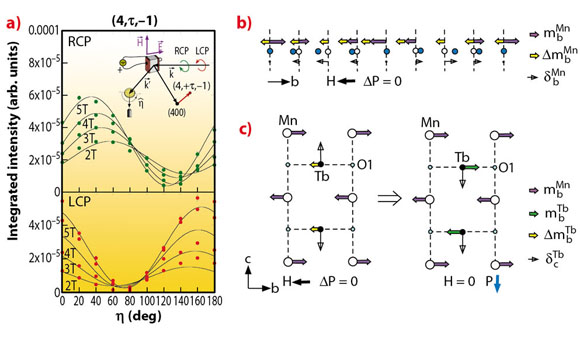- Home
- Users & Science
- Scientific Documentation
- ESRF Highlights
- ESRF Highlights 2011
- Electronic structure and magnetism
- Femtoscale magnetoelastic distortions in multiferroic TbMnO3
Femtoscale magnetoelastic distortions in multiferroic TbMnO3
TbMnO3 is the canonical spin-cycloid multiferroic where a strong cross coupling between ferroelectric and magnetic long-range order exists, as demonstrated by the onset of ferroelectricity at a magnetic phase transition, and the magnetic field control of the ferroelectric polarisation axis [1]. Although numerous experiments have provided a comprehensive description of the magnetic structure, the driving mechanism behind the ferroelectricity has proved more elusive, with two competing theoretical scenarios: one purely electronic [2], and the other based on ionic displacements arising due to antisymmetric exchange interactions [3]. Our experiments decisively support the ionic displacement mechanism in TbMnO3, revealing that both symmetric and antisymmetric interactions need to be included into the microscopic models; and thus our results represent an important step forward towards the goal of realising the technological potential of these materials.
A non-resonant X-ray scattering investigation of TbMnO3 under applied magnetic field has revealed the possibility of finding magnetic and charge displacive amplitudes of the same order of magnitude superposed at the same reflection. By analysing the interference between the magnetic and charge displacive amplitudes, we are able to obtain detailed information regarding the nature of the displacements as a function of applied magnetic field. Our experimental setup (inset Figure 74a) applies an electric field along the c-axis and a magnetic field along the b-axis of the sample. The incident X-rays are converted to a circular polarisation state using a diamond crystal as a quarter-wave phase plate. The scattered X-ray polarisation state is determined by performing a complete Stokes polarimetry analysis using appropriate analyser crystals.
 |
|
Fig. 74: a) Magnetic field and polarisation dependence of the interference scattering. The inset describes the experimental setup. b) Mn displacements arising due to an imbalance in neighbouring magnetisation densities resulting from the b-component of the spin cycloid and the uniform induced moment in a magnetic field. c) Magnetoelastic distortions of the Tb atoms along the c-axis due to the symmetric interaction between the Tb moment and the alternating Mn moment in an applied magnetic field and zero field, giving rise to a spontaneous ferroelectric polarisation in zero magnetic field. |
As shown in Figure 74a, it was found that the intensity of the scattering varies as a function of applied magnetic field, below the critical field for the polarisation flop transition. In particular the amplitudes of the scattering for left and right circularly polarised (LCP and RCP) incident X-rays become more equal and the minima are approaching zero, indicating that the scattering process is effectively converting the incident circular polarisation state into a linear polarisation state.
There are no reports in the literature of a change in the magnetic structure below the transition field, and indeed the data shown in Figure 74a could only be fitted by including charge scattering into our calculations for the scattering cross-section. The physical origin of the charge scattering is the magnetostrictive atomic displacements due to interactions between the zero field moments and those induced by the applied magnetic field, which have the same periodicity as the magnetic ordering (Figure 74b).
A specific feature of these experiments is that they were performed at three different energies to enable the separation of the signals arising from the Tb and Mn ions through the changing ratio of the dispersion corrections for the atomic scattering factors. By analysing the results for two reflections (4,![]() ,±1) at the three energies we have established different displacement modes. One of the dominant modes responsible for the charge scattering is the Tb motion of 19±2 fm/T along the c-axis. It is the symmetric interaction between the Tb induced moment along b with the zero field parallel component of the Mn moment which leads to this displacement (Figure 74c). These displacements are in anti-phase and therefore sum to give zero net electric polarisation.
,±1) at the three energies we have established different displacement modes. One of the dominant modes responsible for the charge scattering is the Tb motion of 19±2 fm/T along the c-axis. It is the symmetric interaction between the Tb induced moment along b with the zero field parallel component of the Mn moment which leads to this displacement (Figure 74c). These displacements are in anti-phase and therefore sum to give zero net electric polarisation.
By relating the size of the induced moment along b on the Tb ions in a magnetic field, with the magnitude of the b-component of the moment in zero field, we can estimate the magnitude of the zero field atomic displacements, obtaining 21±3 fm for the Tb displacements along c. However, in contrast to the magnetic field situation, in zero field these displacements are in phase along c (Figure 74c), giving an electric polarisation of ~150 µC/m2. Thus we have revealed a mechanism concurrent to the Dzyaloshinskii-Moriya interaction, due to a symmetric interaction between parallel moments, which produces an electric polarisation which accounts for one quarter of that observed in bulk measurements
Principal publication and authors
H.C. Walker (a), F. Fabrizi (a,b,c), L. Paolasini (a), F. de Bergevin (a), J. Herrero-Martin (a), A.T. Boothroyd (c), D. Prabhakaran (c) and D.F. McMorrow (b), Science 333, 1273 (2011).
(a) ESRF
(b) University College London (UK)
(c) University of Oxford (UK)
References
[1] T. Kimura et al., Nature 426, 55 (2003).
[2] H. Katsura, N, Nagaosa and A.V. Balatsky, Phys. Rev. Lett. 95, 057205 (2005).
[3] I.A. Sergienko and E. Dagotto, Phys. Rev. B 73, 094434 (2006).



